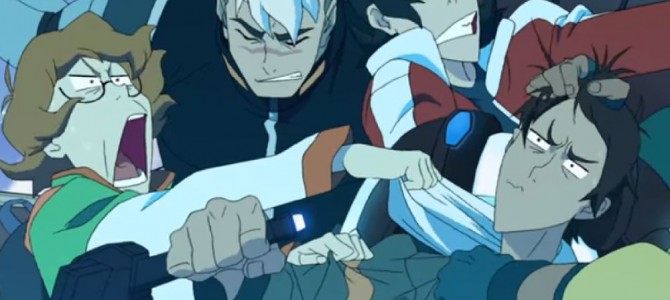
Most modern kids’ shows are awful. When my kids started watching TV shows, I took to downloading British or vintage shows. So in winter of 2012, while looking for more grown-up fare for my nine-year-old, I stumbled upon a reboot of “Voltron,” in which an older Pidge brings an Earth band to Arus to give a concert for the environment.
The original cartoon told a story about a planet ravaged by conquest. The few remaining people lived in caves to avoid the slave raids. The sole surviving member of the ruling family was a 16-year-old princess who lived under a ruined castle. Five space explorers arrived to resurrect the lion ships that they traveled to find, hoping they were not myth. They figured out how to combine to form the mighty robot Voltron, Defender of the Universe.
It was cheesy and full of cartoon mullets—as if mullets in real life weren’t bad enough. But the story was epic. I loved it. Alas, in 2012 that epic tale had become “Josie and the [Mechanical] Pussycats.” Since myth destruction was one of my blog topics and that swill was the last I wanted to swallow, I set out to find the whys and hows of this story devastation. I ended up on FanFiction.net a few hours later.
In all my geeky years, I had never read fan fiction. I found a haven where the original, rich characters lived. I also found that fan fiction is to women what sports radio is to men, a place where their voices can be freely heard.
I read “Voltron” fan fiction for weeks. I made friends with authors. I started beta-editing. (I hang out in some geeky groups, but let me tell you, “I beta edit ‘Voltron’ fan fiction” usually ends the “Who’s the geekiest?” game.) This past weekend, my fellow fangirls and I binged on the new Netflix reboot of Voltron.
Netflix Builds a New Voltron
Anticipation for “Voltron: Legendary Defender” was high. Even I, a trained cynic on reboots and adaptions, had some hope because Netflix has been data-mining viewer habits for years and has amassed a viewer base large enough to devise a Seldon Plan for entertainment. (This is a Voltron review, so I figure the explainer link to the Asimov term isn’t strictly necessary, but provided for convenience for any more typical readers.)
Netflix knows what shows get binge-watched and when the binges start. They know which plot twists fail and how viewers respond to the straight character or the comic relief. They know when audiences stop watching a show—for an hour or forever. They also know these things not at the episode level but at the scene level.
Netflix builds TV seasons the way Gen Xers wield the subtle art of the mix tape: “You gotta kick off with a killer, to grab attention. Then you got to take it up a notch, but you don’t wanna blow your wad, so then you got to cool it off a notch. There are a lot of rules.” There are a lot of rules, and Netflix has figured out most of them.
I agree with much in the glowing Legendary Defender reviews. Netflix got a lot right. There is a solid story. The dialogue is polished. The voice actors are excellent. With a glaring and nebulous exception, the characters are well-written and have plenty of possibilities for development. The animation is both skilled and full of nods to the old anime style and some of the original Japanese elements.
(“Voltron” was the first anime cartoon adapted to the U.S. market. The story we know in the United States was grafted onto the animation for the 52-episode “Beast King GoLion.” They had to use a few filler scenes from other anime cartoons, as producers thought GoLion too risqué, violent, or sad for American kids. Some—ahem—watched both versions for comparisons. For example, Sven, who was injured and sent to a Galaxy Garrison M*A*S*H to recover in the American version, died in the original.)
So what is the glaring and nebulous exception to Netflix’s generally excellent reboot? The women.
Netflix’s Math Misses the Mary Sue
To get the feminist seal of approval for a strong female character, that character has to do it all, all by herself. It’s in the feminist manual, under the heading “A Woman Needs a Man Like a Fish Needs a Bicycle,” and the section opens: “The consummate modern woman doesn’t ever need help because women can do everything a man can do in high heels and backwards.”
In the case of the new Voltron, this means that instead of the 16-year-old princess who has been hiding under her castle with her deceased father’s advisor for 10 years, the one who must learn how to fight and how to rule from the men around her, we get the 20-year-old confident ruler princess, the one who argued toe-to-toe with her father about defending the planet before he got the jump on her and stuck her in a magical sleep for 10,000 years. She awakes, almost instantly ready to take control. Her father’s hologram memory—Netflix borrows favorite elements from other franchises, so we have Superman’s father’s crystal memory and “Stargate” wormholes in this reboot—apologizes to Allura in the first episode. He should have taken her advice, he tells her.
There’s little character growth potential for her. She’s already in complete control. The other female main character, whom I won’t name for spoiler reasons, is the wisest, most knowledgeable, and likable in the show—oh, and a STEM gal to boot. These practically perfect and completely self-sufficient female characters are so notorious that fan critics have a term for them: Mary Sue.
“Mary Sue” started, as so many of these fan terms have, in 1970s Star Trek fan fiction. Paula Smith wrote a parody fic, “A Trekkie’s Tale,” about a 15-year-old girl named Mary Sue who “won the affections of all major male characters, surpassed their skills in combat, ensured their escape from enemy forces with a single hairpin, was granted the Noble Peace prize (among other titles) for flying a spaceship with ease, and then died tragically as all four of her male suitors wept unabashedly over her body.”
Outside of parody, Mary Sues are dull. If that were the worst of their offensives, I wouldn’t much care. But Mary Sues lie, and those lies have consequences.
The Fantastical Making of a Mary Sue
Usually the Mary Sue’s creator gives her some super power to negate the strength and stature disadvantages of the female sex. The latest and popular example is Rey, or MaRay Sue, as the “Honest Trailer for The Force Awakens” bills her. Her instant Force, flying, and fighting competence is textbook Mary Sue. Occasionally, a creator will support a Mary Sue by omitting female vulnerabilities. Think Katniss or Tris in dystopias remarkably free from worries about sexual violation.
When we hold such characters up as positive examples of female power to young women, we leave them open to all sorts of shock. We give them the impression—the false impression—that a tough-girl attitude is all a woman requires for a successful life. Reality dishes out harsh lessons to such naïveté.
But Mary Sues don’t just harm women. To protect their Sues, writers also neuter their male characters.
One of the sour notes in the Voltron reaction has been Coran. In the original, Coran was Allura’s wise mentor, a cross between Luke Skywalker’s Obi Wan Kenobi and Bruce Wayne’s Alfor. In the new Voltron, Coran is the bumbling comic relief. Likewise, Allura’s spectral advisor father, a constant source of wisdom for her in the ’80s cartoon, disappears mid-season in the reboot. Keith, Allura’s love interest and the only member of the team to whom she deferred in the original, is pushed to the background. The character is hardly developed.
Fans hope that will change in the next season, but frankly I see the groundwork for Lance and Keith slash. (“Slash” refers to homosexual parings, which started with Kirk/Spock fics.) Fair warning to Netflix: Star Wars fangirls did not take kindly to the destruction of Han and Leia. The fangirls who ship for Keith and Allura won’t either. (“Ship” is another fan-fiction-created word. “Relationship” got chopped and verbed.)
All men have to be beneath the Mary Sue so there is no hint of a male overshadowing the female. This insults women. It testifies to an assumption that a powerful woman cannot exist among powerful men. This doesn’t make women strong. It makes them lonely.
Even with the Mary Sues, however, “Voltron, Legendary Defender” is one of the better myth cartoons to come out in the last decade. I can’t quite decide if that makes me excited or depressed.









